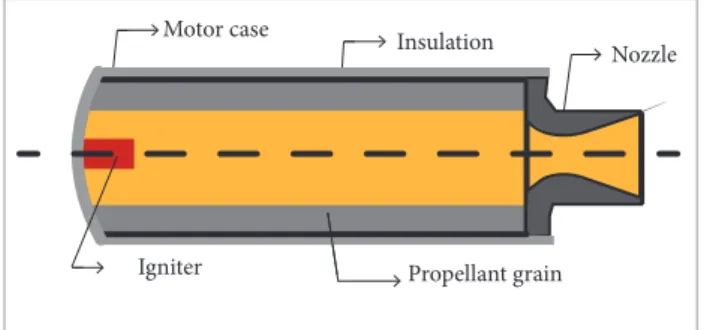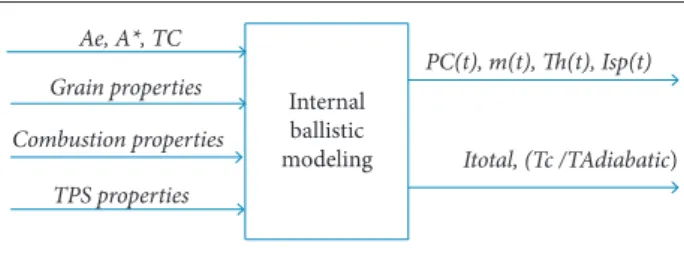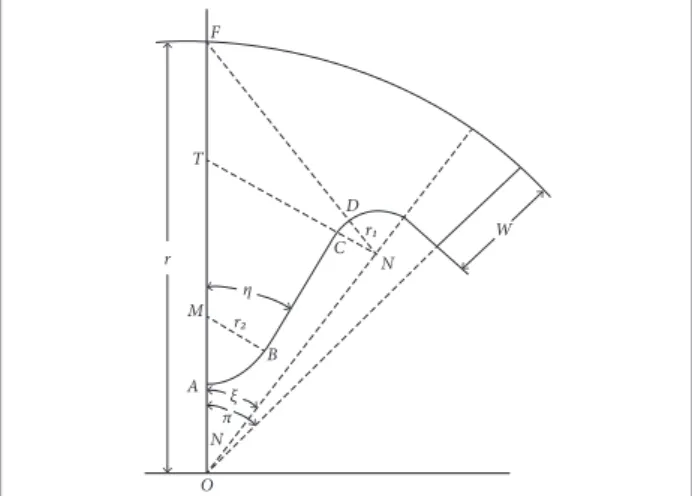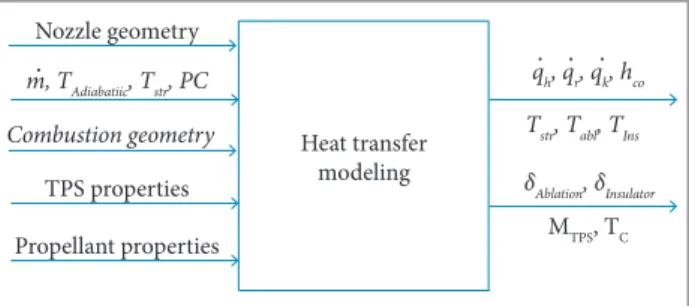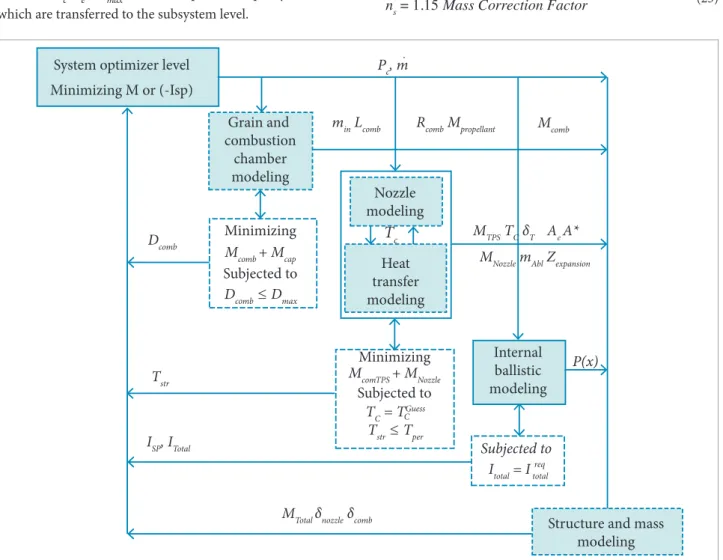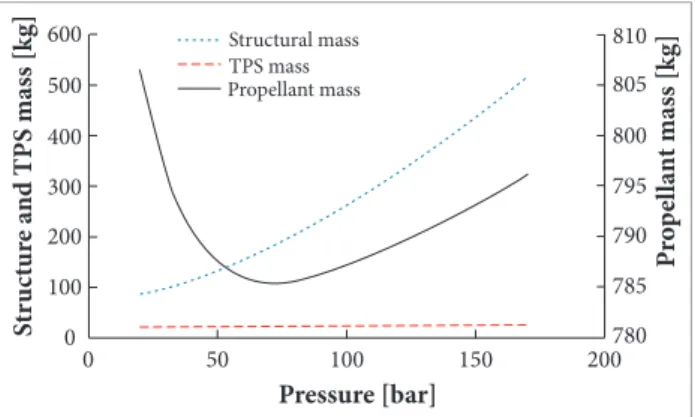ABSTRACT: The optimum design of a solid propulsion system consists of optimization of various disciplines including structure, aerothermodynamics, heat transfer, and grain geometry. In this paper, an eficient model of every discipline has been developed, and a suitable framework is introduced for these hard-coupled disciplines. Hybrid optimization algorithm is used to ind the global optimum point including genetic algorithm and sequential quadratic programing. To show the performance of the proposed algorithm, the required correction factor values have been carefully derived using comparison between more than 10 real solid propulsion systems and the proposed algorithm results. According to the results, the derived correction factors are close to 1, with scattering level better than 0.97. In addition, it is shown that the proposed algorithm (errors < 8%) is more accurate in comparison with the conventional approach (errors < 17%). Then, for a case study, multidisciplinary analysis has been done based on 3 general objectives including dry mass, total mass, and speciic impulse. It means that the optimum speciic impulse is not the maximum value and the optimum dry mass is not the minimum value. Finally, the proposed algorithm can be used to directly derive the optimum coniguration for every mission requirement.
KEYWORDS: Multidisciplinary design, Hybrid optimization, Heat transfer, Solid propulsion, Ablation.
A New Approach to Multidisciplinary Design
Optimization of Solid Propulsion System
Including Heat Transfer and Ablative Cooling
Amirhossein Adami1, Mahdi Mortazavi2, Mehran Nosratollahi1INTRODUCTION
Solid thrusters are widely used in space applications, especially in orbital maneuvers and launch vehicles, and solid boosters are the most important part of space transportation
mission. Heavy launch vehicles use solid boosters as semi irst
stage, and upper stages use solid thruster to reach destination orbit. Reentry vehicles need to deorbit with high amount of impulse in short time, therefore, they use solid propellant propulsion (Adami 2015). Interests grow up because of higher safety and lower required dynamic parts. These applications of solid propulsion thrusters lead to the development of a renewed interest in optimum designing methods. Conventional design methods are involved in subsystems optimization, but a local optimum solution can be found. For example, in
view of propulsion discipline, higher speciic impulse (Isp)
is considered as a better propulsion, while lower structure mass is better in view of structure discipline. Total mass is a reasonable estimation of cost, which includes Isp and structure mass (thermal protection materials, nozzle, and combustion chamber mass). Optimization of each part conflicts with the others. For example, increase in pressure of combustion chamber increases the Isp (lower required propellant mass), while more structure thicknesses are needed. Thus, designing variables should be optimized according to the system level. To do this, solid propulsion system is broken down into 4 major subsystems including combustion chamber, divergent-convergent (D-C) nozzle, solid propellant grain, and thermal protection system (TPS). The mass modeling of each subsystem
1.Maleke Ashtar University of Technology – Aerospace Department – Tehran – Iran. 2.University of Isfahan – Faculty of Engineering – Esfahan – Iran.
Author for correspondence: Amirhossein Adami | Maleke Ashtar University of Technology – Aerospace Department | Babae Highway, Lavizan |1774-15875 – Tehran – Iran | Email: adami_amir@mut.ac.ir
is introduced based on aerothermodynamics, structure, heat transfer, and materials.
Single discipline optimization is more attractive, especially for internal ballistic performance optimization (Hainline 2006) or grain optimization including geometry (Nisar and Guozhu 2008; Nisar et al. 2008) and burn-back simulation (Püskülcü 2004; Yildirim 2007). Albarado et al. (2012) used a particle swarm/pattern search hybrid optimizer to drive an optimum solid rocket motor by concentrating on grain optimization including wagon wheels, dog bones, stars, and multiple tapered sections. Konečný et al. (2007) proposed a traditional method of design that serves for a more accurate determination of the ballistic, weight, and geometric characteristics of the solid propellant rocket motor for the given tactical and technical requirements. In Acik (2010), an optimization tool for internal ballistic design of solid rocket motors was developed using a direct search algorithm. Multidisciplinary design and optimization strategy for the conceptual design of a multistage ground-based interceptor have been carried out in Zeeshan
et al. (2010) using genetic algorithm (GA) and sequential quadratic programing (SQP) to minimize the total mass. In
Roshanian and Keshavarz (2006), multidisciplinary design optimization was applied to a sounding rocket using response surface methods. In Jodei et al. (2009), multidisciplinary design optimization of a small solid propellant launch vehicle was introduced using system sensitivity analysis.
According to the mentioned references, numerous methods have been developed for optimization of solid thrusters. All of the proposed methods focus on propulsion model simplification because of the increase in design variable parameters. Grain geometry and internal ballistic optimizations are 2 favorite examples of trying to have an optimum configuration, but, as mentioned before, optimizing in 1 discipline does not guarantee a global opti- mum point. In addition, heat transfer from combustion chamber has not been considered in the aforementioned studies, and empirical correction factor (applied in adiabatic temperature) has been usually adopted. In this paper, a new approach of multidisciplinary design optimization will be introduced considering internal ballistic performance, grain geometry, structure mass, nozzle geometry, insulator, and heat transfer. Hybrid optimization algorithm (GA-SQP) is
used to ind the global optimum point in shorter elapsed
time based on minimizing the total mass of solid propulsion system or maximizing Isp.
SOLID PROPELLANT THRUSTER
Generally, the motor case is a cylindrical cover containing solid propellant, igniter, and insulator. he combustion takes place in the motor case; therefore, sometimes, it is referred to as combustion chamber. he schematic diagram of a solid propellant thruster is shown in Fig. 1.
Figure 1. Subsystem of solid propellant thruster.
Motor case
Insulation Nozzle
Propellant grain Igniter
The case must be capable of withstanding the internal pressure resulting from the motor operation, approximately 3 – 30 MPa, with a suicient safety factor. herefore, motor case is usually made either from metal (high-resistance steels or high-strength aluminum alloys) or composite materials (glass, Kevlar®, carbon). Besides the stresses due to the pressure in the chamber, thermal stresses may sometimes be critical and, when the case also serves as light vehicle body, bending loads and inertial forces play an important role in determining the thickness and the material of the motor case as well.
The ignition system gives the necessary energy to the propellant surface to initiate combustion. Ignition usually starts with an electrical signal and has a high speciic energy, being designed to release either gases or solid particles. Conventional heat releasing compounds are usually pyrotechnic materials, black powder, metal-oxidant formulations, and conventional solid rocket propellant.
High temperature of the combustion gases, ranging from approximately 2,000 to 3,800 K, requires the protection of the motor case or other structural subcomponents of the rocket motor. Typical insulator materials have low thermal conductivity and high heat capacity, being usually capable of ablative cooling. Most commonly used insulation materials are ethylene propylene diene monomer (EPDM) with addition of reinforcing materials.
of the propellant is converted to the kinetic one, and thrust is obtained. h e geometry of the nozzle directly determines how much of the total energy is converted to kinetic energy. h erefore, nozzle design has a very important role in the performance of a rocket motor.
Solid propellant is cast in certain configuration and geometry called propellant grain. h e propellant grains can be sub-categorized into 2 main coni gurations: case-bonded and freestanding. Case-bonded grains are directly cast into the motor case already provided with thermal insulation.
h e mentioned parts of solid propellant thruster should be modeled and optimized to have an optimum solution, but some of them have lower ef ect on cost function (mass) such as igniter and insulator. h erefore, these disciplines could be omitted in conceptual phases. On the other hand, although lower ef ect on cost function is negligible, strong ef ect on constrains is critical. Insulator and heat transfer are the examples of such disciplines.
INTERNAL BALLISTIC MODELING
Thrust value and Isp introduce the thruster size and performance. h e mentioned parameters can be calculated by Eq. 1:
where: νburnis the burning rate; Ae is the exit area; νe is the exit velocity of l ow; ρeis the exit density; R is the constant parameter of gas; ρpropellantis the density of the propellant; Aburn
is the burning area; Tcis the combustion chamber temperature;
Pcis the combustion chamber pressure; VCombis the combustion volume.
h e relation between burning rate and chamber pressure is governed by the empirical Eq. 3, also known as Saint Robert’s burn rate law:
(1)
(3)
(2) where: Tvacis the vacuum thrust; A* is the throat area; P
e is the exit pressure; Meis the Mach number at the exit section of the nozzle; γ is the isentropic exponent; m . is the mass l ow; Ispvac is the vacuum specii c impulse.
Well-known relations of mass l ow are introduced by Eq. 2:
h is empirical expression dei nes the burning rate of the propellant. Values of a and n are usually derived from strand burner tests or small sub-scale burning rate test motor i rings at dif erent operating pressures. Accurate relation for burn rate is derived by solving the energy equations at burning surface of the grain. Burning rate is function of combustion pressure, initial temperature, combustion temperature, and velocity of hot gases. If heat transfer is considered, then accurate relation of burning rate can be predicted. Supplementary required equations can be found in Adami (2015), Acik (2010), and Hainline (2006). Flow data of the internal ballistic discipline is illustrated in Fig. 2.
Figure 2. Internal ballistic modeling and input-output diagram.
Grain properties
Combustion properties
TPS properties
Internal ballistic modeling
Ae, A*, TC
PC(t), m(t), Th(t), Isp(t)
Itotal, (Tc /TAdiabatic)
NOZZLE MODELING
nozzle are shown in Fig. 3 and corr elate with the thermodynamic ones. Equation 4 presents the relation between geometry and thermodynamic parameters:
GRAIN GEOMETRY MODELING AND
BURN-BACK ANALYSIS
Burning surface changes during motor operation. Burn-back analysis determines these changes in the grain geometry. The geometric design of the grain ultimately defines the performance characteristics that can be obtained with given propellant type and nozzle. Numerous tools and algorithms (analytical, numerical, and drat ing) are developed to analyze the various grain models. Dif erent thrust-time proi les are required for dif erent missions such as progressive, neutral or boost, and sustain. Dif erent thrust time proi les can be obtained by changing the propellant grain coni guration, which can be categorized as end-burning grain, internal-burning tube, external-burning tube star, slot and combined coni guration (for example, i nocyl geometry). Figure 5 shows some of the grain coni gurations.
(4)
where: λ1is the nozzle correction factor (conical); Zexpansion is the expansion ratio (area); R* is the throat radius; R
cis the combustion chamber radius; Re is the exit section radius; θ1is the half angle of convergent part; θ2 is the half angle of divergent part; Lconis the convergent length of the nozzle; Ldiv is the divergent length of the nozzle.
Combustion chamber
θ1
θ2 Dt
DC De
Dport
Dport Dout
End
burning Star
Slot Internal
burning
Figure 3. Nozzle geometric parameters.
Combustion product gases have an erosive ef ect with their high temperature, high velocity, and with a high concentration of liquid and solid particles like metal oxides inside them. h e material selection of the nozzle is a very important step of nozzle design, especially for the throat region, where erosive ef ects are more dominant. Refractory metal, carbon-containing composites or graphite, and reinforced plastic that will withstand erosive ef ects are commonly used as throat material. Flow data of the nozzle discipline is illustrated in Fig. 4.
r2
r1 D T
F
W C
M η
B
A ξ
π
r N
N
O
Each grain configuration has specific design variables. End-burning configuration needs 2 design variables, star grains need 8 independent design variables, and slot grains need 6 design variables. In this paper, available designing and analyzing codes are used, which have been verii ed before. For example, design variables of star grain are introduced in Fig. 6.
Figure 5. Grain coni gurations.
Figure 6. Star grain design variables.
Nozzle modeling
PC, TC, m
θ1, θ2, Zexpansion δNozzle, MNozzle Ae, A*, LNozzle
1.1
L
GrainGrain radius and length specify combustion chamber length and radius, respectively. h us, combustion chamber geometry is derived using Eq. 5:
chamber (internal-external burning) can be proposed as shown in Fig. 8.
(5)
(6)
(7)
(8) T1
min, T01 mout, T02
Cin Cout
qr–str
Grain Structure
Insulator TPS
Ablative TPS
Combustion
T2 qk
QAbl
q2TPS
q3TPSq4TPS qγ qγ
Tstr
Tabl
h r
.
.
.
.
.
P P
Grain type
Grain design and combustion
chamber modeling
Areq burn, Areq port
Ab(w), Ap(w), LGrain
VComb, VComb, RGrain
Grain geometry parameter where: LGrain is the grain length; Lc is the combustion chamber length; RGrain is the grain radius; dTPSis the required TPS thickness which will be derived in the next section.
h e l ow data of the grain discipline is illustrated in Fig. 7.
Figure 7. Grain design and input-output diagram.
HEAT TRANSFER DISCIPLINES
Heat transfer from combustion chamber and thermal modeling of solid propellant thrusters are among the important disciplines in propulsion design algorithm. Hard coupling between thermal limitation and thruster’s performance (such as pressure, mass l ow, etc.) takes place due the use of shared parameters in dif erent disciplines (Adami 2015; Darabi et al. 2015). Analytical and computational tools were developed for over-cooled walls (Knab et al. 2009) but known computational and analytical methods are usually involved in CFD and longtime consumption. Such accuracy and time consumption are not needed for conceptual and preliminary design phase. h us, engineering model can be useful to rapidly predict the heat l ux. In this paper, rapid thermal modeling of combustion chamber is introduced, and thermal protection system mass with real combustion temperature is predicted.
The largest part of the heat is transferred from the hot chamber gases to the chamber walls by convection and radiation. h e amount of heat transferred by conduction (gas) is small and usually negligible in preliminary design phases. In Adami (2015), it is shown that the best performance and minimum TPS mass are obtained by selection of 2 TPS layers. h e i rst is ablative to control temperature, and the second is absorber to control heat l ux. h e thermal equilibrium of combustion
Figure 8. Thermal equilibrium of solid thruster with ablation and radiation.
In this model, it is considered that l ow enters the control volume at er combusting with adiabatic temperature T01:
Combustion products lose energy by convection q .γ
h and radiation q .γ
r .
where: Tsis the inner TPS wall (ablative TPS) temperature; T ~ the is mean temperature of the combustion chamber; Cin
P is the input specii c heat cof ecient at constant pressure; T02 is a temperature of the combustion chamber at er heat transferred (real temperature).
h e prediction of convective heat coei cient (hy) is the most important part of thermal modeling of every combustion chamber. Sutton and Biblarz (2010) proposed Eq. 8 for prediction of hyand q .γ
Huzel et al. (1992) proposed Eq. 9 for prediction of hy and
q .γ
r .
It should be noted that, if wall temperature is lower than ablative temperature, then ablation does not happen. Additionally, if inner burning grain such as star grain is considered, then hot gas does not touch the combustion chamber wall and ablation does not happen again. Input energy of ablation mass l ow (q . 3
TPS) absorbs some energy again until it reaches the real combustion chamber temperature and leaves the control volume.
(9)
(10)
(11)
(12)
(13)
(14)
(15)
(16) Equations 8 and 9 need many inputs that are usually not
available. Adami (2015) suggests Eq. 10, which is especially suitable for multidisciplinary design optimization:
where: R is a constant parameter of gas combustion products; gis an isentropic exponent; Pr is Prandtl number; m is viscosity; Mg is the molecular weight; CP is the specii c heat at constant volume; A is the cross section of the flow (A* < A < A
comb); Alatis the lateral area; Zcis a correction factor that depends on combustion chamber geometry.
Input energy warms up the wall (Ts), and the wall temperature approaches the maximum value called abla-tive temperature (TAbl). Ablative TPS begins to ablate, and the decomposition of ablative materials is complex, involving many and multifarious physical and chemical processes (Martin 2013). General relation of ablation is presented in Eq. 11:
where: ρAblis the ablative TPS density; r .Abl is the ablation velocity; CAblis the ablation heat coei cient.
Some of the absorbed energy comes back to the combustion flow by radiation from hot wall and ablation mass flow at ablation temperature.
Structure of chamber should be protected from high temperature. Ablative TPS keeps the inner wall temperature near constant but this temperature is high enough to melt any structure. Ablative materials have generally high density and high conductive heat coei cient (KAbs). It is not good to use ablative material as an insulator, therefore, a second TPS layer is proposed. Conductive heat from 2 TPS layers is i nally emitted by radiation from lateral surface of structure.
where: dAblationand dInsulatorare the ablative and insulator thickness, respectively.
Equation 14 are time-dependent, but critical condition can be rewritten as Eq. 15 for steady state condition.
Steady state condition and thermal equilibrium for propellant l ow, TPS and total control volume lead to Eq. 16.
(8)
h ese 3 equations have 4 unknowns including T02, m .Abl,
but unique answer will be derived from Eq. 16 if Tstris known or specii ed. Finally, total TPS mass can be predicted by Eq. 17:
Convergent part of nozzle is designed based on T02including throat area. Flow enters the convergent part with T02 and exits from throat with total temperature T03. Divergent part of the nozzle is designed based on T03 including exit area. Finally, l ow enters the divergent part with T03 and exits from the nozzle with total temperature Tc.
MASS PREDICTION AND
CORRECTION FACTORS
Total thruster mass (combustion chamber, cap, TPS, propellant, and nozzle) is estimated from Eq. 19:
(19)
(20) As mentioned before, if ablation is not needed, then Eq. 18
can be used alternatively. Unknowns are T02, dInsulator, and Ts.
Internal burning grain does not need ablative TPS in combustion, but ablative material is needed for throat of the nozzle. Properties of some thermal protection materials are summarized in Table 1 (NASA 1968, 2015). Finally, l ow data of the heat transfer discipline is illustrated in Fig. 9.
To rapidly model the heat transfer, it is proposed to select three sections including combustion chamber, convergent part of the nozzle, and divergent part of the nozzle. h us, l ow enters with adiabatic temperature and exits with total temperature T02.
C
Abl
(MJ/kg) T
Abl ρ
(Kg/m) Cp
(J/kgK) K
TPS
(W/mK) Material
-1,685
320 740
1.3 Silica
-1,650
310 750
0.82 Silicon carbide
-2,090
512 775
0.62 Alumina
-2,480
736 700
0.14 Zirconia
66.8 3,778
1,400 1,631
1.59 Graphite
47 835
513 1,110
25 Avcoat39-5026
Table 1. Summary of some TPS properties.
TPS properties
Heat transfer modeling
Propellant properties
m, TAdiabatiic, Tstr, PC qh, qr, qk, hco
Tstr, Tabl, TIns
δAblation, δInsulator
MTPS, TC
Combustion geometry Nozzle geometry
.
. . .
Figure 9. Heat transfer discipline and input-output diagram.
(17)
(18)
According to the selected coni gurations, cylindrical geometry is used for combustion chamber. Required thicknesses can be calculated using Eq. 20:
where: nS.Fis a safety factor and is taken close to 2 for space application.
Flow data of mass modeling is illustrated in Fig. 10. Some correction factors are usually applied to compensate the ef ect of the model simplii cation and to adjust the results in comparison with real thrusters. Equation 22 presents the minimum required correction factors to modify the results
:
where: λ2is a temperature correction factor; nsis the mass correction factor.
Values of the mentioned correction factors are adjusted during the validation.
feasibility. Finding an optimum solution in shorter elapsed time needs a more ei cient algorithm.
MDO techniques consist of single-level and multi-level methods such as all at once (AAO), collaborative optimization (CO), bi-level integrated system synthesis (BLISS), and concurrent subspace optimization (CSSO) (Adami et al. 2015a; Adami et al. 2015b). AAO is the most basic MDO technique and has wide industry acceptance. In AAO, control is given to a system-level optimizer that ensures a global objective is met by having a single designer control in the entire system. AAO solves the global MDO problem by moving all local-level design variables and constraints away from each discipline to a new system-level optimizer entrusted with optimizing a global objective. High feasibility in solution is one of the advantages of AAO, but increasing the design variable leads to long optimizing procedure (Adami et al. 2015a). CO is a 2-level MDO algorithm originally developed in 1996 by Braun (1996) and is expected to maintain expert control in each discipline as well as incorporate parallel execution by removing iteration loops, presenting a 2-level structure similar to industry organizational structures. To coordinate between disciplines, CO creates copies of all interdisciplinary coupling variables at the system-level. h e system optimizer uses these copies to send out design targets to each discipline. Most disadvantages of CO are values convergence and low feasibility in solution because of more system constraints.
Solid propulsion system design including heat transfer is a complex problem, which has looped disciplines. For example, heat l ow calculation needs thruster geometry while geometry depends on TPS thicknesses. Decoupling of such disciplines leads to increase in system-level optimization variables and decrease in feasibility. h us, new approach of MDO is used, which has higher ei ciency for hard coupling systems. In this framework, shared variables between disciplines are only selected as design variables and all the other design variable should be optimized in a subsystem-level. New subspaces are introduced by integrating concurrent connected disciplines. A copy of system-level cost function is created for internal disciplines optimization. It is clear that the minimum optimization of system-level variables is used with maximum feasibility.
Hybrid optimization methods use a combination of gradient-based and heuristic methods. An example of hybrid method is to use a heuristic method to move towards a global solution area, and switch to a second order gradient-based method to quickly move towards the i nal solution. h erefore, hybrid optimization methods utilize advantages of both gradient-based
Figure 10. Mass modeling.
MTPS, Mpropellant
Mass modeling
MThruster RC, LC, PC
(21)
(22)
MULTIDISCIPLINARY DESIGN
OPTIMIZATION ALGORITHM
methods and heuristic methods by combining the speed of local optimization with the robustness of global optimization. GA and SQP are common pair of hybrid optimization methods and are applied in this paper as system-level optimizer. Internal disciplines optimization is done by SQP algorithm. Flow data of multidisciplinary design optimization of solid thruster is proposed in Fig. 11.
Colored disciplines have an internal optimization. As shown in Fig. 11, only 2 design variables ( Pc, m.) are needed for optimum design of solid propulsion system with speciic thrust level and burning time. Minimum total mass will be derived by trading off between minimum propellant mass and minimum dry mass. Total mass (MTotal) is considered as a cost function, which should be minimized. Total impulse (ITotal =Ireq
Total ) is considered as a system equality constrains. Structure temperature (Tstr≤ Tper) and maximum permitted diameter (
D
c, De ≤ Dmax) are most important inequality constrains which are transferred to the subsystem level.VALIDATION
Modeling of each part of the solid thruster should be complex enough to have an acceptable estimation of thruster mass, geometry, and performance. Results of the proposed algorithm could be converged to real solid thruster data by using some correction factors. Correction factors are adjusted during validation by comparing the results with over ten real thrusters. Properties of some real solid propulsion are summarized in Table 2. All of the solid propulsion stages use hydroxyl-terminated poly butadiene (HTPB).
Figure 12 shows the mass relation, and Fig. 13 shows the Isp relation between real thrusters and the proposed algorithm. According to the results, the values of correction factors are proposed as relations:
Figure 11. Flow data of multidisciplinary design optimization of solid thruster.
System optimizer level Pc, m
min Lcomb
Minimizing
Mcomb + Mcap
Subjected to
Dcomb≤ Dmax
Subjected to Itotal = I total
Minimizing
McomTPS + MNozzle
Subjected to
TC = TGuess
Tstr ≤ Tper
Rcomb Mpropellant Mcomb
MTPS TC δTPSAe A*
MNozzle mAbl Zexpansion
P(x)
T
cDcomb
Tstr
ISP, ITotal
MTotal δnozzle δcomb
Minimizing M or (-Isp)
Grain and combustion
chamber modeling
Heat transfer modeling
Nozzle modeling
Internal ballistic modeling
Structure and mass modeling
req
.
C
(23)
λ2 = 0.97Adiabatic Temp. Correction Factor
When the correction factors values are close to one, then, it can be said that modeling is accurate. By using the above value of the correction factor, the proposed results are equipped with experimental data. he worst case is related to third stage of Pegasus® launch vehicle. Comparison between the 3rd stage of Pegasus® launch vehicle and the proposed
Figure 13. Comparison between real Isp and MDO result.
Mreal= 1.1499*MMDO R² = 0.998
0 20000 40000 60000 80000 100000 120000
0 20000 40000 60000 80000 100000 120000
R ea l T ota l M ass (k g )
Total Mass from Algorithm (kg)
Mreal = 1.1499 × MMDO
R2 = 0.998
0
0 20,000 40,000 60,000 80,000 100,000 120,000
Total mass from algorithm [kg]
R
ea
l t
o
ta
l mass [kg]
20,000 40,000 60,000 80,000 100,000 120,000
Ispreal= 0.9969*IspMDO R² = 0.967
275 280 285 290 295 300 305 310 315
275 280 285 290 295 300 305 310 315
Real Isp (s)
Isp from Algorithm (s)
Ispreal = 0.9969 × IspMDO
R2 = 0.967
285 285 280 280 275 275
Isp from algorithm [s]
R ea l I sp [s] 290 290 295 295 300 300 305 305 310 310 315 315
Figure 12. Comparison between real total mass and MDO result.
Ispvac (s) Length (m) Diameter (m)
Exit diameter of the nozzle (m)
Total mass (kg)
Propellant mass (kg)
Orion 38 287 1.35 0.97 0.53 891 770
Proposed
algorithm 289.2 1.32 0.96 0.49 864 789
Error 0.8% 2.2% 1% 7.5% 3% 2.5%
Adiabatic method 312.7 1.39 0.9 0.44 777 727
Error 8.9% 2.9% 7.2% 17% 13% 5.6 %
Table 3. Results comparison between real thrusters and the presented algorithm.
Solid propulsion Ispvac
(s) Length (m) Diameter (m) Dry mass (kg) Propellant mass (kg) Thrustvac (ton) Burning time (s) Expansion ratio (area)
Orion 38 (Pegasus®) 287 1.34 0.97 121 770 3.66 68.5 49.3
Orion 50SXL (Pegasus®) 295 10.27 1.28 1,370 15,010 70.23 69.1 34.3
Orion 50XL (Pegasus®) 289 4.29 1.28 360 3,930 16.37 69.7 43.5
P80FW (Vega) 279.5 11.71 3.0 7,330 88,365 310 109.8
-Zeiro 23 (Vega) 289 8.39 1.9 1,900 23,900 121.96 86.7
-Zeiro 9A (Vega) 294 3.85 1.9 780 10,115 31.92 128.6
-SR-118 (Minotaur) 282 8.39 2.34 3,620 45,370 226.8 56.4
-SR-119 (Minotaur) 309 7.88 2.34 3,180 24,490 124.7 60.7
-SR-120 (Minotaur) 300 2.33 2.34 640 7,070 29.48 72
-Star 48VB (Minotaur) 292.1 2.077 1.24 155 2,009 ~ 7 84.1
-Star 37FM (Minotaur) 289.8 1.69 0.93 812 1,066 4.82 62.7
-Table 2. Real solid propulsion speciications.
Figure 14. Variation of TPS mass, propellant mass, and structure mass.
0
0 50 100 150 200
Pressure [bar]
S
tr
u
ct
ur
e a
nd TPS mass [kg]
P
ro
p
el
la
n
t mass [kg]
100 200 300 400 500
600 Structural mass
TPS mass Propellant mass
785
780 790 795 800 805 810
Figure 15. Variation of total mass and Isp.
0 20 40 60 80 100 120 140
Pressure [bar]
Is
p [s]
T
o
ta
l mass [kg]
283 284 285 286
279 280 281 282 287 288
880 900 920 940
820 840 860 960 980
Isp Total mass
According to the results of Table 3, the proposed algorithm has acceptable accuracy in mass modeling (error ≤ 3%), thruster’s dimensions estimation (error ≤ 7.5%) and performance prediction (error ≤ 1%). Such accuracy is suitable enough to be used in preliminary design phases. Errors become larger (near 17%) if the heat transfer discipline is not considered.
MULTIDISCIPLINARY DESIGN ANALYSIS
OF SOLID PROPULSION SYSTEM
Optimum length, diameter, expansion ratio, Isp, and operating pressure can be estimated using multidisciplinary design analysis. It means that optimum Isp value is not the maximum value and optimum dry mass is not the minimum value. For example, analysis of Orion-38 is done, and the results are presented as follows.
Because of constant mass low, the combustion chamber pressure is the only optimization variable. According to the results of Fig. 14, increase in combustion chamber pressure leads to an increase in TPS mass and structure mass (dry mass) but a decrease in propellant mass. here is a minimum point for propellant mass that is related to variation of Isp. If heat transfer is not considered, then Isp increases with increase in combustion chamber pressure and propellant mass is decreased. Variation of total mass and Isp are illustrated in Fig. 15.
As shown in Fig. 15, optimum Isp and optimum total mass occur in diferent pressures of combustion chamber. Maximum Isp occurs in pressures near 70 bar, and the minimum total mass occurs in pressures near 30 bar. It should be noted that all of the above solid propulsion systems have a similar total impulse. he optimum coniguration with maximum Isp is nearly 4% heavier than the optimum coniguration with the minimum total mass. However, combustion chamber pressure of Orion-38 was selected as 45.23 bar.
SUMMARY AND RESULTS
In this paper, a new approach to multidisciplinary design optimization of a solid propulsion system has been introduced. he required disciplines have been considered including structure, aerothermodynamics, heat transfer, and grain geometry. Heat transfer from thruster was modeled and the governing equations of the combined ablative and radiative cooling were proposed. Adding the heat transfer discipline into the design procedure
increased diiculty and complexity due hard-coupled disciplines. To overcome this, a new MDO framework was introduced which is more eicient for such hard-coupled disciplines. he results of the proposed algorithm have been compared with more than ten operational solid propulsion systems. he derived correction factors are close to one with scattering level better than 0.97. According to the results, inclusion of heat transfer discipline in the model improved the accuracy of the numerical calculations. Maximum error was reduced from 17 to 8%. As a case study, Orion 38 has been selected. By using MDO, the optimum coniguration is directly derived including total length, combustion chamber diameter, expansion ratio, nozzle geometry, Isp, operating pressure, ablative TPS mass, and grain geometry.
AUTHOR’S CONTRIBUTION
Acik S (2010) Internal ballistic design optimization of a solid rocket motor (Master’s thesis). Ankara: Middle East Technical University.
Adami A (2015) Multidicsiplinary design optimization of Reentry Vehicle considering Guidance Algorithm (PhD thesis). Tehran: Amirkabir University of Technology.
Adami A, Mortazavi M, Nosratollahi M (2015a) Multi-modular design optimization and multidisciplinary design optimization. International Journal of Intelligent Unmanned Systems 3(2-3):156-170. doi: 10.1108/IJIUS-01-2015-0001
Adami A, Mortazavi M, Nosratollahi M, Taheri M, Sajadi J (2015b) Multidisciplinary design optimization and analysis of hydrazine monopropellant propulsion system. International Journal of Aerospace Engineering 2015:Article ID 295636. doi: 10.1155/2015/295636
Albarado K, Hartield R, Hurston W, Jenkins R (2012) Solid rocket motor design using hybrid optimization, International Journal of Aerospace Engineering 2012:Article ID 987402. doi: 10.1155/2012/987402
ATK (2008) Alliant Techsystems Inc. Tactical Propulsion and Controls. 14 May 2008. Approved for Public Release OSR No. 08-S-0259 and OSR No. 08-S-1556. Dulles: ATK.
Braun RD (1996) Collaborative architecture for large-scale distributed design (PhD thesis). Stanford: Stanford University.
Darabi H, Roshanian J, Zare H (2015) Design of liquid-propellant engine using collaborative optimization and evolutionary algorithms. Proc IME G J Aero Eng 229(2):232-242. doi: 10.1177/0954410014529423
Hainline RC (2006) Design optimization of solid rocket motor grains for internal ballistic performance (Master’s thesis). Orlando: University of Central Florida.
Hosseini M, Toloie A, Nosratollahi M, Adami A (2011) Multidisciplinary design optimization of an expendable launch vehicle. Proceedings of the International Conference on Recent Advances in Space Technologies; Istanbul, Turkey.
Huzel DK, Huang DH, Arbit H (1992) Modern engineering for design of liquid-propellant rocket engines. Washington: American Institute of Aeronautics and Astronautics.
Jodei J, Ebrahimi M, Roshanian J (2009) Multidisciplinary design optimization of a small solid propellant launch vehicle using system sensitivity analysis. Structural and Multidisciplinary Optimization
38(1):93-100. doi: 10.1007/s00158-008-0260-5
Knab O, Frey M, Görgen J, Maeding C, Quering K, Wiedmann D (2009) Progress in combustion and heat transfer modeling in rocket thrust chamber applied engineering. Proceedings of the 45th AIAA/ASME/ SAE/ASEE Joint Propulsion Conference & Exhibit; Denver, USA.
Konečný P, Hrubý V, Křižan Z (2007) Design optimization of solid propellant rocket motor. Proceedings of the 23rd International Symposium on Ballistics; Tarragona, Spain.
Martin HT (2013) Assessment of the performance of ablative insulators under realistic solid rocket motor operating conditions (PhD thesis). State College: Pennsylvania State University.
NASA (1968) NASA/SP-8009, Propellant slosh loads, NASA SPACE VEHICLE DESIGN CRITERIA (Structures), Washington: NASA.
NASA (2015) TPSX Update - Nov. 2015; [accessed 2016 Oct 29]. https://tpsx.arc.nasa.gov
Nisar K, Guozhu L (2008) A hybrid approach for design optimization of wagon wheel grain for SRM. AIAA 2008-4893.
Nisar K, Guozhu L, Zeeshan Q (2008) A hybrid optimization approach for SRM FINOCYL grain design Chin J Aeronaut 21(6):481-487. doi: 10.1016/S1000-9361(08)60164-8
Orbital (2010) Pegasus® user’s guide. Release 7.0; [accessed 2016 Oct 29]. www.georing.biz/usefull/Pegasus_UG.pdf
Püskülcü G (2004) Analysis of 3-D grain burnback of solid propellant rocket motors and veriication with rocket motor tests (Master’s thesis). Department of Mechanical Engineering; Ankara; Turkey.
Roshanian J, Keshavarz Z (2006) Multidisciplinary design optimization applied to a sounding rocket. J Indian Inst Sci 86(4):363-375.
Sutton GP, Biblarz O (2010) Rocket propulsion elements. 8th edition. Hoboken: John Wiley & Sons.
Yildirim C (2007) Analysis of grain burnback and internal low in solıd propellant rocket motors in 3 dımensıons (PhD thesis). Ankara: Middle East Technical University.
Zeeshan Q, Yunfeng D, Nisar K, Kamran A, Raique A (2010) Multidisciplinary design and optimization of multistage ground-launched boost phase interceptor using hybrid search algorithm. Chin J Aeronaut 23(2):170-178. doi: 10.1016/S1000-9361(09)60201-6
